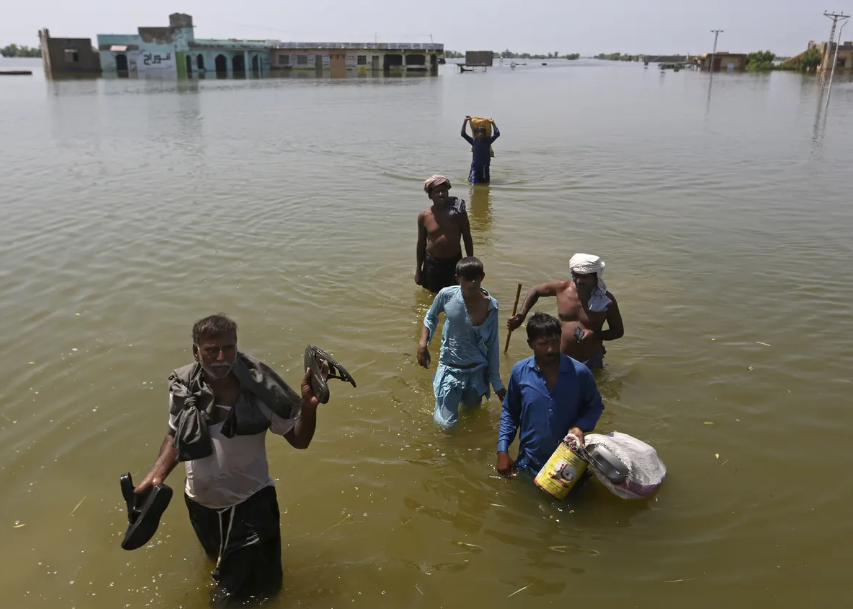Laura Shorten wrote in “Mzemo“:
One-Third Of Pakistan Submerged By “Monsoon On Steroids”
The world has faced much climate crisis devastation over the decades. However, in August 2022, the climate carnage in Pakistan brought this crisis into a whole new ball game. The image above is from the New Humanitarian, showing people attempting to flee the floods. The climate-induced flooding has affected over 50 million people. This disaster has left one-third of Pakistan underwater, with some parts resembling “a small ocean”.
The Pakistan flooding indicates the consequences of the universal and rapacious climate crisis unravelling at unprecedented speed. However, it seems that most of the world hasn’t considered Pakistan’s epic humanitarian crisis for what it represents.
Pakistan has a famine looming, $30 billion in economic loss, 50 million people internally displaced, and a high threat of a malaria epidemic present as floodwater lies stagnant. Furthermore, an entire generation in Pakistan is deprived access to essential services in health and education. Deaths will rise with colder winter months approaching and millions left without homes.
Climate Crisis In Pakistan Is Beyond Bleak
For decades, Pakistan has seen record-breaking temperatures, torrential rains, glacial melt, droughts, and floods. This current weather disaster is the most extreme torrential rainfall and devastating flash floods Pakistan has seen in 73 years. Millions have fled their homes with little more than rags to protect them from scorching high temperatures of 40 degrees Celsius. Pakistan is one of the world’s top ten most vulnerable countries on the Climate Risk Index but only contributes to less than 1% of global greenhouse gas emissions.
Pakistan’s National Disaster Management Authority updated the death toll from the crisis since mid-June to 1,545 people and 552 children. This disaster spurred the United Nations to issue its largest-ever disaster appeal, at over $2 billion.
The Plight Of Pakistani Children During A Climate Crisis
The flooding has adversely affected millions of children since the crisis started. Due to the extreme flooding, children in Pakistan are battling diarrhoea, malaria, dengue fever, and painful skin conditions. According to UNICEF, 3.4 million children urgently need immediate life-saving support and humanitarian assistance.
Approximately 16 million children are without homes, lack access to safe drinking water, and live in unsanitary conditions. Millions of children are at increased risk of water-borne diseases, drowning, and malnutrition. In addition, the flooding exacerbates the threat of snakes, scorpions and mosquitoes, all of which carry life-threatening diseases.
The International Communities Response To The Climate Crisis
There has been silence from prominent international figures and western media outlets concerning Pakistan. In the first week of the floods, more newspaper articles covered the Finnish prime minister’s social life than the unfolding weather event. This questions the global outlook and prioritization concerning climate change.
The flooding has sparked an ongoing debate regarding broader issues of responsibility for loss and damage endured by nations affected by climate change. Global warming is primarily caused by the Global North’s disregard for the environment and excessive release of greenhouse gas emissions. However, despite the Global North’s overwhelming contribution to the crisis, there is still a complete disregard for the pain suffered by Pakistanis in its international response.
Double Standards And Racism In Response To Various Humanitarian Crisis‘
The international response to Pakistan is minuscule compared to Ukraine, where around 12 million people were displaced. Comparatively, this figure represents a third of the displaced people in Pakistan, reaching over 50 million. World leaders criticize the international community’s focus on the war in Ukraine. The same attention is not given to crises in other parts of the world. The mass media apply double standards to reporting depending on the race and nationality of those affected by the humanitarian crisis.
The international communities’ weak response is either a form of racism and ideology that terrible things happen in places like Pakistan or an utter failure of compassion.
Climate Change Discriminates Against Women And Girls
Women and children are facing a dangerous downwards spiral of hunger and malnutrition. In Pakistan, there are 650,000 pregnant women and girls. Moreover, 73,000 mothers are expected to deliver in the coming weeks. The United Nations Population Fund (UNFPA) says many women lack access to health-care facilities and support to deliver their children safely.
Climate change continues to exacerbate maternal and newborn health inequities. Aid groups report that many mothers are anaemic and malnourished and deliver very low-weight babies. In addition, mothers are too ill to breastfeed their children.
Pakistan has one of the highest maternal mortality rates in South Asia. The majority of Pakistani women give birth at home. However, with millions of homes destroyed, many women do not know where they will deliver their babies in the coming months or years.
The Pakistani crisis highlights how climate change disproportionately impacts women and girls. In Sindh province, more than 1,000 health facilities have been fully or partially destroyed. In Balochistan province, flooding damaged 198 health facilities.
“I am deeply concerned about the potential for a second disaster in Pakistan: a wave of disease and death following this catastrophe, linked to climate change, that has severely impacted vital health systems leaving millions vulnerable”
World Health Organization (WHO) chief Tedros Adhanom Ghebreyesus.
Political Instability In Pakistan
In August 2022, Pakistan had a 27% inflation rate. The Pakistani rupee crashed, and net foreign reserves fell to $8 billion. Pakistan continues to face political instability due to a showdown involving the government, the military, and ex-prime minister Imran Khan. This makes it difficult to carry out an effective flood response and begin rebuilding people’s lives.
Furthermore, political instability has resulted in food insecurity and electricity and fuel shortages.











